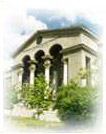| ENG RUS | Timus Online Judge |
1966. Cycling RoadsTime limit: 1.0 second Memory limit: 64 MB When Vova was in Shenzhen, he rented a bike and spent most of the time
cycling around the city. Vova was approaching one of the city parks
when he noticed the park plan hanging opposite the central entrance. The
plan had several marble statues marked on it. One of such statues stood
right there, by the park entrance. Vova wanted to ride in the park on the
bike and take photos of all statues. The park territory has multiple
bidirectional cycling roads. Each cycling road starts and ends at a marble
statue and can be represented as a segment on the plane. If two cycling
roads share a common point, then Vova can turn on this point from one
road to the other. If the statue stands right on the road, it doesn't
interfere with the traffic in any way and can be photoed from the road. Can Vova get to all statues in the park riding his bike along cycling
roads only? InputThe first line contains integers n and m that are the number of statues and
cycling roads in the park OutputPrint “YES” if Vova can get from the park entrance to all the park
statues, moving along cycling roads only, and “NO” otherwise. Samples
Problem Source: Open Ural FU Personal Contest 2013 Tags: graph theory |
